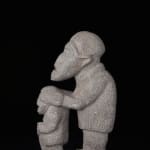Kissi Soapstone Pombo Sculpture of a Man and Child, 14th Century CE - 18th Century CE
Soapstone
16.75
PF.6151 (LSO)
Further images
This unusual stone figure of a standing man (?) and child is a Pombo sculpture made by the Kissi group of Sierra Leone. Multifigural pieces are very unusual, but the...
This unusual stone figure of a standing man (?) and child is a Pombo sculpture made by the Kissi group of Sierra Leone. Multifigural pieces are very unusual, but the representations are highly typical, with elongated faces, protuberant eyes and comparatively large heads. The figures are dressed in what appear to be tunics that reach to the knee. The smaller figure – who stands in front of the main individual – is holding a staff in his hands. The base is narrow and elongated, and does not extend beyond the feet of the figures.
The Kissi are a language group that is spread across modern Sierra Leone, and includes other tribes such as the Bassa; they are known in art-history circles as the Sapi-Grebo. They are mainly rice farmers, with vegetable gardens and some livestock (notably cows, which are considered sacred, and reserved for sacrifices). Villages tend to be small, and run by members of the Poro society; a system of gerontocracy is also in operation. Some Kissi adhere to traditional beliefs that are centred around Pombo, Mahen Yafe and Nomoli figures, which are dug up in the fields and revered as ancestors (Pombo – the generic name for these items – literally means “the deceased”) or “rice gods”. They are stored under houses, libated and even beaten with sticks to derive the maximum spiritual benefit from them.
Little is known of the way these pieces were carved and used. It has been claimed that they are a localised offshoot of early Portuguese incursions into the area (15th – 16th century), but there is little stylistic or historic basis to support this assertion. The major distinctions between the figures are that the Mahen Yafe are primarily heads adorned with extravagant facial hair and jewellery, while the Pombo (as called by the Mende) figures have crested hairstyles and filed teeth. The Nomoli are very much as depicted by the current piece, although they are sometimes bearded. The only data regarding age is a radiometric date on a rare wooden piece, which yielded a date between 1190 and 1394 AD.
More ornate examples may represent chiefs, while the less anthropomorphic probably represent spirits. The modern Kissi are highly superstitious, and live in fear of the supernatural. They have talismans to protect them from the unknown, and especially from witches. Their robust treatment of statues reflects this tendency. So it is possible that the figures, while far from their original context, are in fact being used much in the way that they were intended to be.
This is a fascinating and well-carved piece of ancient African art.
The Kissi are a language group that is spread across modern Sierra Leone, and includes other tribes such as the Bassa; they are known in art-history circles as the Sapi-Grebo. They are mainly rice farmers, with vegetable gardens and some livestock (notably cows, which are considered sacred, and reserved for sacrifices). Villages tend to be small, and run by members of the Poro society; a system of gerontocracy is also in operation. Some Kissi adhere to traditional beliefs that are centred around Pombo, Mahen Yafe and Nomoli figures, which are dug up in the fields and revered as ancestors (Pombo – the generic name for these items – literally means “the deceased”) or “rice gods”. They are stored under houses, libated and even beaten with sticks to derive the maximum spiritual benefit from them.
Little is known of the way these pieces were carved and used. It has been claimed that they are a localised offshoot of early Portuguese incursions into the area (15th – 16th century), but there is little stylistic or historic basis to support this assertion. The major distinctions between the figures are that the Mahen Yafe are primarily heads adorned with extravagant facial hair and jewellery, while the Pombo (as called by the Mende) figures have crested hairstyles and filed teeth. The Nomoli are very much as depicted by the current piece, although they are sometimes bearded. The only data regarding age is a radiometric date on a rare wooden piece, which yielded a date between 1190 and 1394 AD.
More ornate examples may represent chiefs, while the less anthropomorphic probably represent spirits. The modern Kissi are highly superstitious, and live in fear of the supernatural. They have talismans to protect them from the unknown, and especially from witches. Their robust treatment of statues reflects this tendency. So it is possible that the figures, while far from their original context, are in fact being used much in the way that they were intended to be.
This is a fascinating and well-carved piece of ancient African art.





